Page 37 of 514

36 Getting startedUnlockingPosition 0
Before you press the KEYLESS-GO
start/stop button, the vehicle’s on-board
electronics have status0 (as with
SmartKey removed).
Position 1�
Press the KEYLESS-GO start/stop
button once.
This supplies power for some electrical
consumers, such as seat adjustment.Ignition (or position 2)
�
Press the KEYLESS-GO start/stop but-
ton twice.
This supplies power for all electrical
consumers. All the lamps (except low
beam headlamp indicator lamp, high
beam headlamp indicator lamp, and
turn signal indicator lamps unless acti-
vated) in the instrument cluster come
on. If a lamp in the instrument cluster
fails to come on when the ignition is
switched on, have it checked and re-
placed if necessary. If a lamp in the in-
strument cluster remains on after
starting the engine or comes on while
driving, refer to “Lamps in instrument
cluster”(
�page 374).For more information, see “SmartKey with
KEYLESS-GO*” (
�page 100).
For information on starting the engine
using the KEYLESS-GO start/stop button,
see “Starting with KEYLESS-GO*”
(
�page 49).
iIf you now press the KEYLESS-GO
start/stop button �
once again, the ignition (position2)
is switched on.
�
twice, the power supply is again
switched off.
iIf you now press the KEYLESS-GO
start/stop button once, the power sup-
ply is again switched off.
iWhen you switch on the ignition, the in-
dicator and warning lamps (except low
beam headlamp indicator lamp, high
beam headlamp indicator lamp, and
turn signal indicator lamps unless acti-
vated) in the instrument cluster come
on. The indicator and warning lamps
(except low beam headlamp indicator
lamp, high beam headlamp indicator
lamp, and turn signal indicator lamps if
activated) will go out when the engine
is running. This indicates that the re-
spective systems are operational.
Page 42 of 514
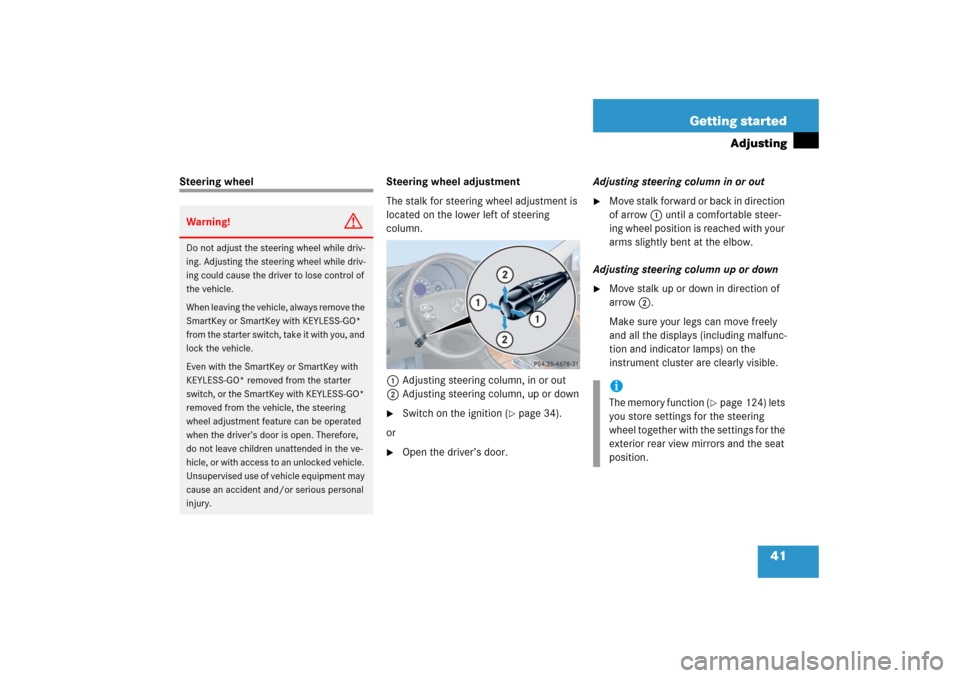
41 Getting started
Adjusting
Steering wheel Steering wheel adjustment
The stalk for steering wheel adjustment is
located on the lower left of steering
column.
1Adjusting steering column, in or out
2Adjusting steering column, up or down
�
Switch on the ignition (
�page 34).
or
�
Open the driver’s door.Adjusting steering column in or out
�
Move stalk forward or back in direction
of arrow 1 until a comfortable steer-
ing wheel position is reached with your
arms slightly bent at the elbow.
Adjusting steering column up or down
�
Move stalk up or down in direction of
arrow 2.
Make sure your legs can move freely
and all the displays (including malfunc-
tion and indicator lamps) on the
instrument cluster are clearly visible.
Warning!
G
Do not adjust the steering wheel while driv-
ing. Adjusting the steering wheel while driv-
ing could cause the driver to lose control of
the vehicle.
When leaving the vehicle, always remove the
SmartKey or SmartKey with KEYLESS-GO*
from the starter switch, take it with you, and
lock the vehicle.
Even with the SmartKey or SmartKey with
KEYLESS-GO* removed from the starter
switch, or the SmartKey with KEYLESS-GO*
removed from the vehicle, the steering
wheel adjustment feature can be operated
when the driver’s door is open. Therefore,
do not leave children unattended in the ve-
hicle, or with access to an unlocked vehicle.
Unsupervised use of vehicle equipment may
cause an accident and/or serious personal
injury.
iThe memory function (
�page 124) lets
you store settings for the steering
wheel together with the settings for the
exterior rear view mirrors and the seat
position.
Page 53 of 514
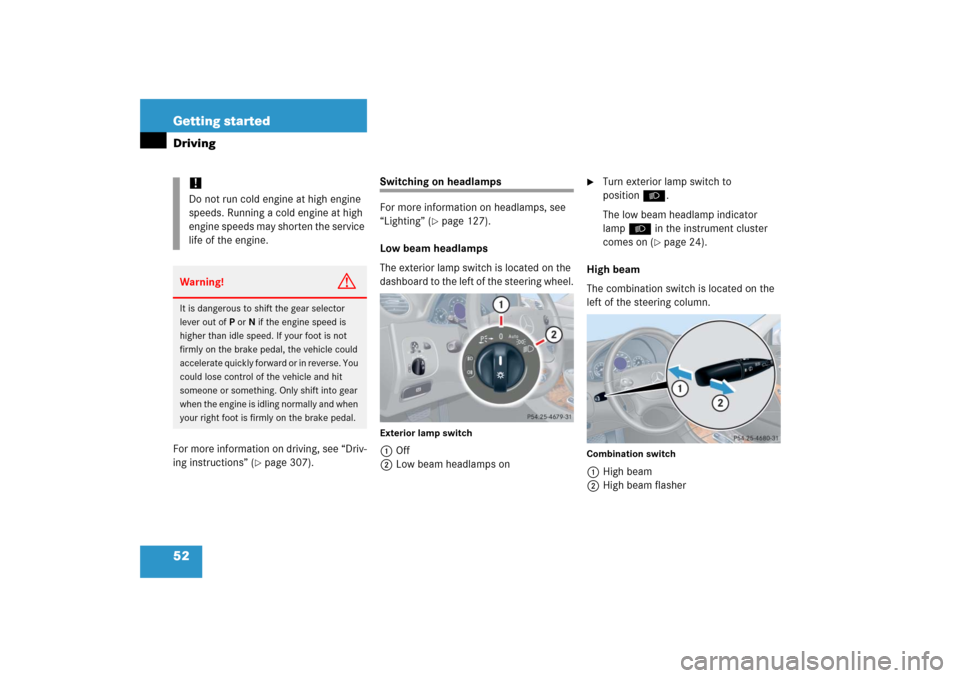
52 Getting startedDrivingFor more information on driving, see “Driv-
ing instructions” (
�page 307).
Switching on headlamps
For more information on headlamps, see
“Lighting” (
�page 127).
Low beam headlamps
The exterior lamp switch is located on the
dashboard to the left of the steering wheel.
Exterior lamp switch1Off
2Low beam headlamps on
�
Turn exterior lamp switch to
positionB.
The low beam headlamp indicator
lampB in the instrument cluster
comes on (
�page 24).
High beam
The combination switch is located on the
left of the steering column.
Combination switch1High beam
2High beam flasher
!Do not run cold engine at high engine
speeds. Running a cold engine at high
engine speeds may shorten the service
life of the engine.Warning!
G
It is dangerous to shift the gear selector
lever out ofPorN if the engine speed is
higher than idle speed. If your foot is not
firmly on the brake pedal, the vehicle could
accelerate quickly forward or in reverse. You
could lose control of the vehicle and hit
someone or something. Only shift into gear
when the engine is idling normally and when
your right foot is firmly on the brake pedal.
Page 54 of 514
53 Getting started
Driving
�
Push combination switch in direction of
arrow1.
The high beam headlamp indicator
lampA in the instrument cluster
comes on (
�page 24).
Turn signals
The combination switch is located on the
left of the steering column.Combination switch1Turn signals, right
2Turn signals, left
�
Press combination switch in direction
of arrow1or2.
The corresponding turn signal indicator
lampLorK in the instrument
cluster flashes (
�page 24).
The combination switch resets automati-
cally after major steering wheel move-
ments.
Windshield wipers
The combination switch is located on the
left of the steering column.Combination switch1Single wipe
Wiping with windshield washer fluid
2Switching on windshield wipers�
Switch on the ignition (
�page 34).
iTo signal minor directional changes
such as changing lanes, press combi-
nation switch only to the point of resis-
tance and release. The corresponding
turn signals will flash three times.
Page 63 of 514
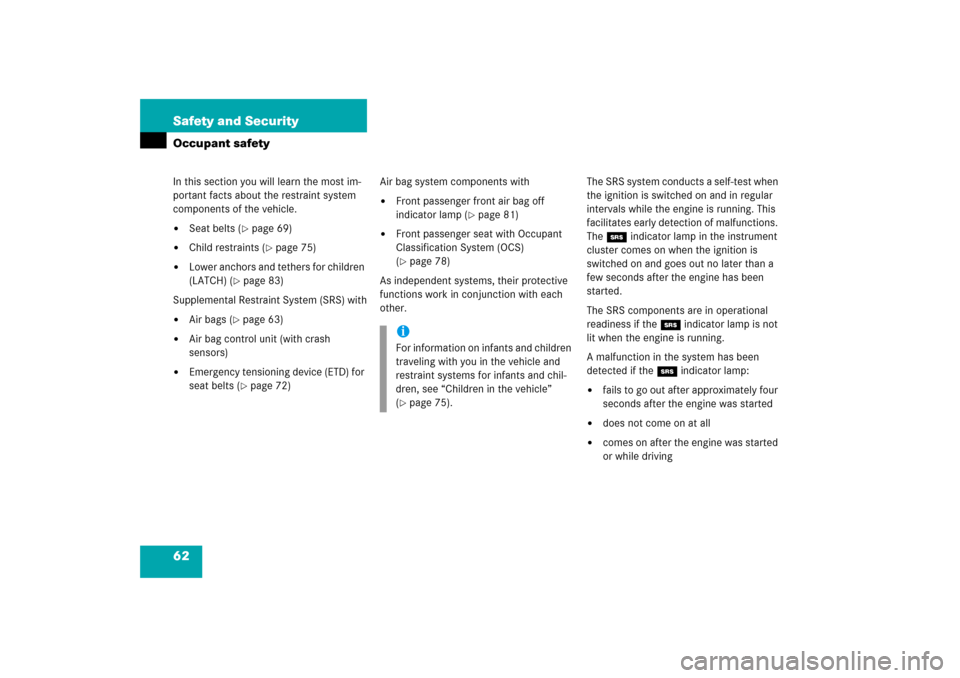
62 Safety and SecurityOccupant safetyIn this section you will learn the most im-
portant facts about the restraint system
components of the vehicle.�
Seat belts (
�page 69)
�
Child restraints (
�page 75)
�
Lower anchors and tethers for children
(LATCH) (
�page 83)
Supplemental Restraint System (SRS) with
�
Air bags (
�page 63)
�
Air bag control unit (with crash
sensors)
�
Emergency tensioning device (ETD) for
seat belts (
�page 72)Air bag system components with
�
Front passenger front air bag off
indicator lamp (
�page 81)
�
Front passenger seat with Occupant
Classification System (OCS)
(�page 78)
As independent systems, their protective
functions work in conjunction with each
other.The SRS system conducts a self-test when
the ignition is switched on and in regular
intervals while the engine is running. This
facilitates early detection of malfunctions.
The
1
indicator lamp in the instrument
cluster comes on when the ignition is
switched on and goes out no later than a
few seconds after the engine has been
started.
The SRS components are in operational
readiness if the
1
indicator lamp is not
lit when the engine is running.
A malfunction in the system has been
detected if the
1
indicator lamp:
�
fails to go out after approximately four
seconds after the engine was started
�
does not come on at all
�
comes on after the engine was started
or while driving
iFor information on infants and children
traveling with you in the vehicle and
restraint systems for infants and chil-
dren, see “Children in the vehicle”
(�page 75).
Page 88 of 514
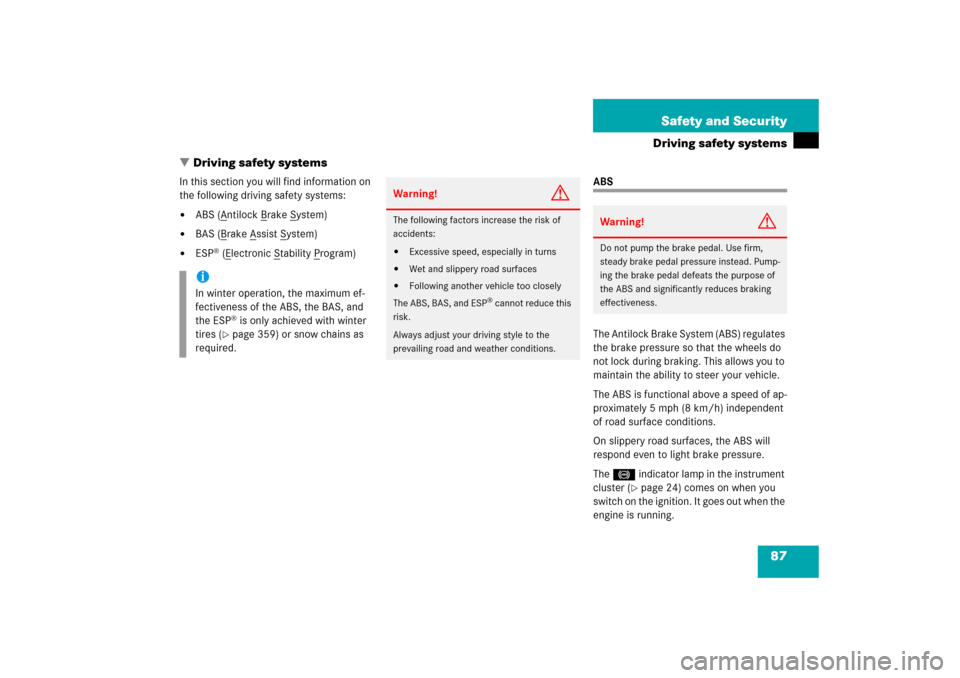
87 Safety and Security
Driving safety systems
�Driving safety systems
In this section you will find information on
the following driving safety systems:�
ABS (A
ntilock B
rake S
ystem)
�
BAS (B
rake A
ssist S
ystem)
�
ESP
® (E
lectronic S
tability P
rogram)
ABS
The Antilock Brake System (ABS) regulates
the brake pressure so that the wheels do
not lock during braking. This allows you to
maintain the ability to steer your vehicle.
The ABS is functional above a speed of ap-
proximately 5 mph (8 km/h) independent
of road surface conditions.
On slippery road surfaces, the ABS will
respond even to light brake pressure.
The - indicator lamp in the instrument
cluster (
�page 24) comes on when you
switch on the ignition. It goes out when the
engine is running.
iIn winter operation, the maximum ef-
fectiveness of the ABS, the BAS, and
the ESP
® is only achieved with winter
tires (
�page 359) or snow chains as
required.
Warning!
G
The following factors increase the risk of
accidents:�
Excessive speed, especially in turns
�
Wet and slippery road surfaces
�
Following another vehicle too closely
The ABS, BAS, and ESP
® cannot reduce this
risk.
Always adjust your driving style to the
prevailing road and weather conditions.
Warning!
G
Do not pump the brake pedal. Use firm,
steady brake pedal pressure instead. Pump-
ing the brake pedal defeats the purpose of
the ABS and significantly reduces braking
effectiveness.
Page 90 of 514
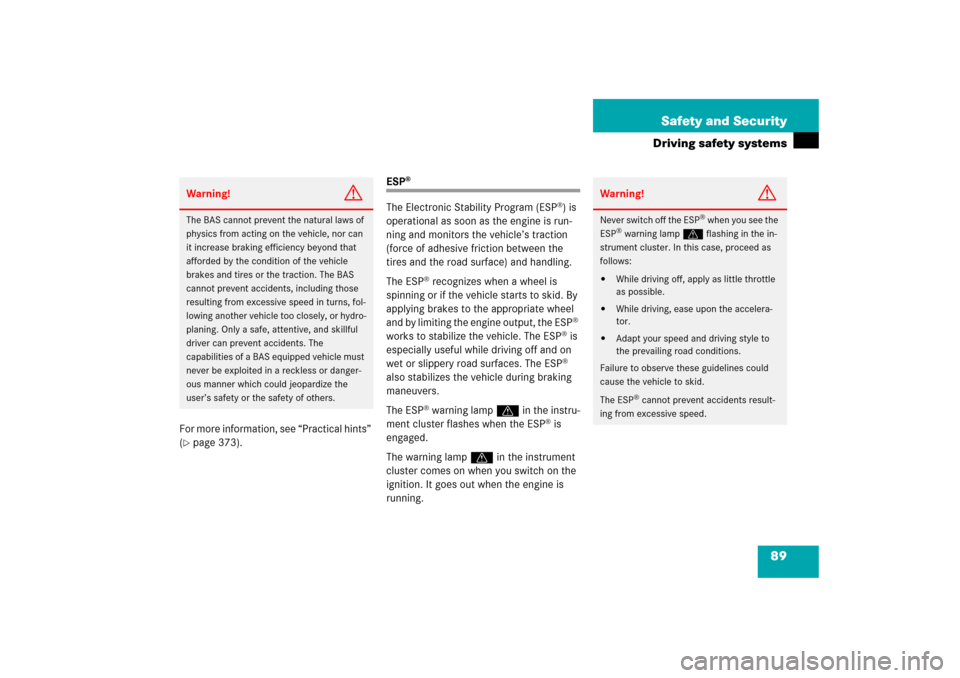
89 Safety and Security
Driving safety systems
For more information, see “Practical hints”
(�page 373).
ESP
®
The Electronic Stability Program (ESP
®) is
operational as soon as the engine is run-
ning and monitors the vehicle’s traction
(force of adhesive friction between the
tires and the road surface) and handling.
The ESP
® recognizes when a wheel is
spinning or if the vehicle starts to skid. By
applying brakes to the appropriate wheel
and by limiting the engine output, the ESP
®
works to stabilize the vehicle. The ESP
® is
especially useful while driving off and on
wet or slippery road surfaces. The ESP®
also stabilizes the vehicle during braking
maneuvers.
The ESP
® warning lamp v in the instru-
ment cluster flashes when the ESP
® is
engaged.
The warning lamp v in the instrument
cluster comes on when you switch on the
ignition. It goes out when the engine is
running.
Warning!
G
The BAS cannot prevent the natural laws of
physics from acting on the vehicle, nor can
it increase braking efficiency beyond that
afforded by the condition of the vehicle
brakes and tires or the traction. The BAS
cannot prevent accidents, including those
resulting from excessive speed in turns, fol-
lowing another vehicle too closely, or hydro-
planing. Only a safe, attentive, and skillful
driver can prevent accidents. The
capabilities of a BAS equipped vehicle must
never be exploited in a reckless or danger-
ous manner which could jeopardize the
user’s safety or the safety of others.
Warning!
G
Never switch off the ESP
® when you see the
ESP
® warning lamp v flashing in the in-
strument cluster. In this case, proceed as
follows:
�
While driving off, apply as little throttle
as possible.
�
While driving, ease upon the accelera-
tor.
�
Adapt your speed and driving style to
the prevailing road conditions.
Failure to observe these guidelines could
cause the vehicle to skid.
The ESP
® cannot prevent accidents result-
ing from excessive speed.
Page 96 of 514
95 Controls in detail
Locking and unlocking
Seats
Memory function
Lighting
Instrument cluster
Control system
Automatic transmission
Good visibility
Climate control (CLK 350)
Automatic climate control (CLK 500/CLK 55 AMG)
Audio system
Power windows
Soft top
Driving systems
Loading
Useful features